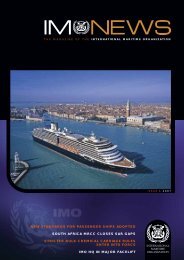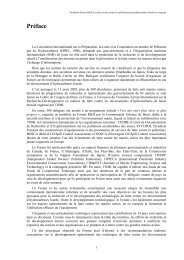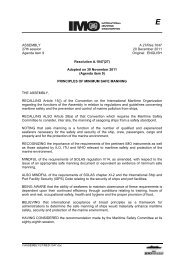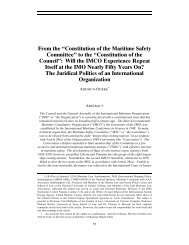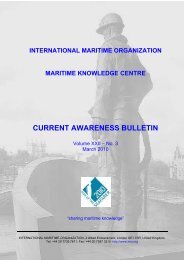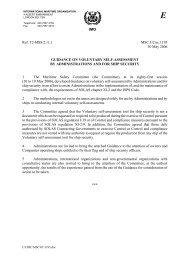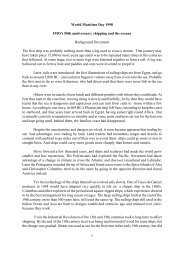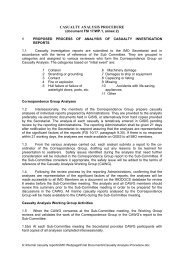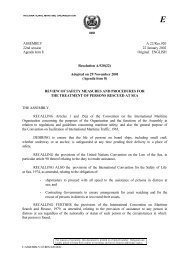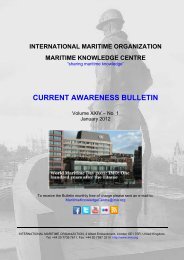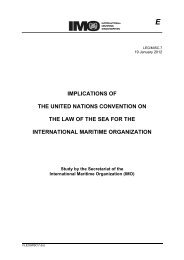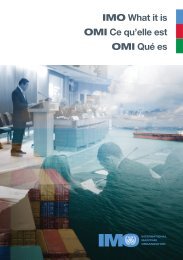Radioactive Waste Disposal at Sea: Public Ideas ... - IMO
Radioactive Waste Disposal at Sea: Public Ideas ... - IMO
Radioactive Waste Disposal at Sea: Public Ideas ... - IMO
Create successful ePaper yourself
Turn your PDF publications into a flip-book with our unique Google optimized e-Paper software.
26 Chapter 2<br />
(McDougal and Burke 1985, pp. 864–868). Although st<strong>at</strong>es pledged to<br />
cooper<strong>at</strong>e and take relevant “measures,” neither the precise n<strong>at</strong>ure of these<br />
measures nor any minimum standards were specified (Schenker 1973, p.<br />
37). “In essence,” writes Frye (1962, p. 29), “the conference produced no<br />
community policy <strong>at</strong> all on the m<strong>at</strong>ter.” 16<br />
The conference resolution, which did not have the force of a tre<strong>at</strong>y, further<br />
recommended th<strong>at</strong> the Intern<strong>at</strong>ional Atomic Energy Agency, an agency<br />
of the United N<strong>at</strong>ions th<strong>at</strong> promotes the peaceful use of nuclear power,<br />
undertake studies of the technical and scientific problems connected with<br />
sea disposal of radioactive waste. An IAEA panel established for this purpose<br />
concluded in 1961 th<strong>at</strong>, although there was no general hazard <strong>at</strong> th<strong>at</strong><br />
time associ<strong>at</strong>ed with ocean dumping of radioactive waste, such hazards<br />
could become significant in the future. 17 Further, the panel concluded th<strong>at</strong><br />
ocean disposal of high-level waste could not be recommended and th<strong>at</strong> lowlevel<br />
waste should be dumped only under controlled conditions. The panel<br />
proposed an intern<strong>at</strong>ional accord to keep radioactive hazards from accumul<strong>at</strong>ing<br />
to unacceptable levels. However, this proposal was never embodied<br />
in an intern<strong>at</strong>ional convention. 18<br />
Starting in 1967, a voluntary mechanism set up by the Nuclear Energy<br />
Agency of the Organiz<strong>at</strong>ion for Economic Cooper<strong>at</strong>ion and Development<br />
provided guidelines and undertook supervisory responsibility for disposal<br />
of low-level waste from NEA member countries (Holcomb 1982, p. 184).<br />
Th<strong>at</strong> same year, the first NEA-supervised intern<strong>at</strong>ional nuclear waste dumping<br />
oper<strong>at</strong>ion was carried out, <strong>at</strong> a depth of 5000 meters in the eastern<br />
Atlantic. The primary objectives of the NEA were “to develop, <strong>at</strong> the intern<strong>at</strong>ional<br />
level, a safe and economic method for ocean disposal and to<br />
demonstr<strong>at</strong>e this by a joint experimental disposal oper<strong>at</strong>ion involving several<br />
member countries.” 19 Belgium, France, the Federal Republic of<br />
Germany, the Netherlands, and Britain supplied some 35,000 containers<br />
of waste weighing nearly 11,000 tons and containing approxim<strong>at</strong>ely 8000<br />
Ci of radioactivity. The primary dumpers—Belgium, the Netherlands,<br />
Switzerland, and Britain—particip<strong>at</strong>ed in a series of coordin<strong>at</strong>ed dumping<br />
oper<strong>at</strong>ions th<strong>at</strong> took place in 1967, in 1969, and in each year from 1971 to<br />
1982. France, Italy, Sweden, and the Federal Republic of Germany particip<strong>at</strong>ed<br />
in only the first two dumping oper<strong>at</strong>ions. The regionally coordin<strong>at</strong>ed<br />
dumping called for agreement on dump-site selection, package design for<br />
the waste m<strong>at</strong>erial, facilities available on the dumping vessel, and duties of



